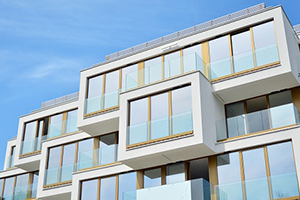After the longest economic expansion in American history, a 2020-2021 recession was expected to arrive to cool down market growth and stabilize asset values. Less expected, it goes without saying, was a global pandemic that would freeze much of the economy and set it on an uncertain path for months to come.
Multifamily real estate — specifically income-generating property — has generally been a stable, high-return asset class as people always need a place to live. When we founded ArborCrowd to give individuals access to commercial real estate investment opportunities that were previously only available to very high-net-worth investors or institutions, our choice to focus on multifamily assets was clear because of this stability and because The Arbor Family of Companies has many decades of experience with this asset class.
The multifamily sector isn’t immune from the uncertainty brought on by COVID-19, and it remains to be seen how the rapid rise of unemployment will affect the industry as households struggle to pay rent. But despite a lack of clarity about the future, we can study past recessions to understand what may lie ahead for multifamily real estate. Data from prior recessions, in fact, shows that the multifamily sector consistently outperformed other real estate asset classes. According to a 2019 report by CBRE, multifamily rental rates exceeded those in the office and industrial sectors in the 2001 recession and all major property sectors, including office, industrial and retail, during the 2008-2009 recession.
And even as COVID-19 has a direct impact on rental income, the federal government’s $2 trillion stimulus package is already playing a role in stabilizing the multifamily industry as we face the coming recession.
Before considering the current economic challenges, let’s look at the 1990, 2001 and 2008-2009 recessions. It was the 1990 recession that sparked a buying spree among real estate investors, creating the institutionalized multifamily industry that we know today. This sector, which morphed into a respectable investment class on par with owning office buildings and shopping centers, has continually outperformed other asset classes in downturns ever since.
The 2001 recession, which followed the dot-com collapse and 9/11 terrorist attacks, was overall a brief one that only resulted in a GDP decline of less than 1 percent. Still, commercial real estate felt an impact.
 Multifamily rents peaked in the third quarter of 2001 and then declined 6.7 percent over a nine-quarter period before beginning to grow again in the fourth quarter of 2003, after the recession officially ended, CBRE’s report found. It took the multifamily sector just seven quarters until mid-2005 to return to its prior peak. Meanwhile, both office and industrial rents fared worse with deeper declines occurring for even longer periods of time.
Multifamily rents peaked in the third quarter of 2001 and then declined 6.7 percent over a nine-quarter period before beginning to grow again in the fourth quarter of 2003, after the recession officially ended, CBRE’s report found. It took the multifamily sector just seven quarters until mid-2005 to return to its prior peak. Meanwhile, both office and industrial rents fared worse with deeper declines occurring for even longer periods of time.
Office rents declined 17.7 percent over a 13-quarter period before starting to pick up again in mid-2004. It took another 14 quarters until late 2007 to reach pre-recession peak rents. Industrial faced a rent decline of 7.3 percent over a 15-quarter period until it started to rise again in the first quarter of 2005. It then took eight quarters until early 2007 for the sector to regain its prior peak rents.
Additionally, after returning to its peak rents in mid-2005, the multifamily sector continued to grow for the next 12 quarters until the Great Recession began. However, as the office sector only returned to its peak rents in late 2007 and the industrial sector only return to its peak in early 2007, those sectors only experienced six and three quarters of growth, respectively, until the Great Recession.
During the Great Recession of 2008-2009, single-family housing was in the eye of the storm. But compared to office, industrial and retail, multifamily experienced the lowest level of rent decline and shortest period until rents reached their prior peaks, according to the CBRE report.
Multifamily experienced a 7.9 percent cumulative rent decline as compared to mid-17 percent in industrial and office and approximately 14 percent in retail. It then took seven quarters for multifamily to hit its prior peak, in mid-2011, as compared to 13 quarters for industrial, and nine quarters for office. Retail, which has been challenged by the emergence of e-commerce, has yet to reach its prior peak.
Why those outcomes? At the outset of the last recession there was undoubtedly pain for owners and investors as the industry experienced an impact against commercial real estate demand. But falling homeownership rates — caused by the collapse of the single-family housing market — eventually helped drive apartment occupancy, which then boosted the multifamily sector in the eyes of investors worldwide.
With the arrival of new investors, there’s been a price increase over the past decade that’s led to the expectation of our next recession. What’s arrived, of course, looks vastly different than any downturn in U.S. history. There’s still a crucial difference when compared to the Great Recession: back then, real estate was on shaky ground largely fueled by loose lending standards. In today’s market, much of the real estate industry is on sound footing with stronger fundamentals. Additionally, lending standards have not fallen back to the bad habits exhibited prior to the Great Recession. With real estate no longer in the eye of the storm, the overall industry – and especially multifamily assets – are positioned to fare better.
 Another unique facet of the economic crisis we face is the historic stimulus package from the U.S. government that included a cash payment of $1,200 to qualifying Americans, as well as mortgage forbearance and eviction moratoriums for those financially affected by the virus. With countless businesses currently shuttered, many Americans have used — or are expected to use — their stimulus check to contribute to rent. And unlike retail, office and industrial spaces, which have closed across the country in response to social distancing, the “stay-at-home” orders have placed utmost priority on apartments and homes.
Another unique facet of the economic crisis we face is the historic stimulus package from the U.S. government that included a cash payment of $1,200 to qualifying Americans, as well as mortgage forbearance and eviction moratoriums for those financially affected by the virus. With countless businesses currently shuttered, many Americans have used — or are expected to use — their stimulus check to contribute to rent. And unlike retail, office and industrial spaces, which have closed across the country in response to social distancing, the “stay-at-home” orders have placed utmost priority on apartments and homes.
In the months ahead, multifamily operators will adapt to a new normal: from changes in property maintenance, and hygiene and safety to rent collections and managing the spike in home deliveries. The changes will be unprecedented, but owners, operators and investors can take some solace by looking to past recessions. While the downturns of 2001 and 2008-2009 impacted the overall real estate sector, multifamily suffered the least both in rent decreases and recovery time. In this current challenge, which is markedly different from any recession we’ve seen before, there’s optimism that the fundamentals of rigorously underwritten multifamily assets can continue to endure as they have in the past.
